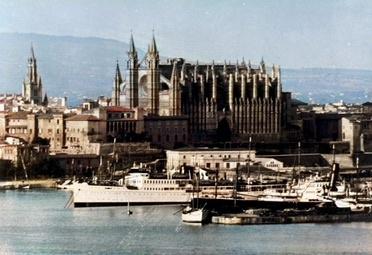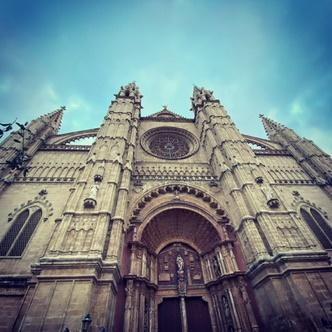How does the interior decoration of Mallorcan churches differ between Gothic and Baroque styles?
Similar Topics
mallorcan churches
gothic interiors
baroque interiors
gothic decoration
baroque decoration
mallorcan craftsmanship
religious artistry
polychrome decoration
The interior decoration of Mallorcan churches reveals a fascinating contrast between the Gothic and Baroque styles, reflecting broader European artistic trends while showcasing local craftsmanship and religious sensibilities. Gothic interiors in Mallorca are characterized by their emphasis on verticality and light, creating a sense of solemnity and spiritual elevation. The design typically features ribbed vaults and pointed arches, which contribute to an airy, spacious atmosphere. Walls and ceilings often remain relatively austere, with decoration limited to restrained stone carvings and delicate tracery, allowing light to filter through stained glass windows in subtle, colorful patterns. Altars and chapels in Gothic churches tend to be simple and elegant, focusing attention on the architectural form rather than excessive ornamentation.
In contrast, the Baroque interiors erected in Mallorca from the 17th century onward are marked by dramatic exuberance and lavish detail. These churches feature richly gilded altarpieces, intricate stucco work, and large-scale frescoes that cover walls and ceilings, offering a visually immersive experience. The goal of Baroque decoration was to inspire awe and engage the senses, often employing bold contrasts of light and shadow alongside dynamic, swirling forms. Sculptural elements in Baroque churches are more pronounced, with religious figures portrayed in expressive poses adorned with elaborate robes and intricate detailing. This style reflects the Counter-Reformation’s push to reassert the emotional power of Catholic worship, and Mallorcan Baroque interiors are no exception in demonstrating a sense of theatricality and spiritual intensity.
While Gothic churches maintain a serene and introspective ambiance, the Baroque spaces invite a more immediate and emotional engagement. In Mallorca, the evolution from Gothic to Baroque also corresponds to an increase in the use of polychrome decoration, with vibrant colors and gilding playing a prominent role in transforming the sacred space. Both styles, however, reveal a deep commitment to craftsmanship and religious devotion, ensuring that each church offers a unique interpretation of faith through its interior aesthetic. Visiting these churches provides a compelling glimpse into the island's rich artistic heritage, where architectural form and decoration tell distinct stories across centuries.
In contrast, the Baroque interiors erected in Mallorca from the 17th century onward are marked by dramatic exuberance and lavish detail. These churches feature richly gilded altarpieces, intricate stucco work, and large-scale frescoes that cover walls and ceilings, offering a visually immersive experience. The goal of Baroque decoration was to inspire awe and engage the senses, often employing bold contrasts of light and shadow alongside dynamic, swirling forms. Sculptural elements in Baroque churches are more pronounced, with religious figures portrayed in expressive poses adorned with elaborate robes and intricate detailing. This style reflects the Counter-Reformation’s push to reassert the emotional power of Catholic worship, and Mallorcan Baroque interiors are no exception in demonstrating a sense of theatricality and spiritual intensity.
While Gothic churches maintain a serene and introspective ambiance, the Baroque spaces invite a more immediate and emotional engagement. In Mallorca, the evolution from Gothic to Baroque also corresponds to an increase in the use of polychrome decoration, with vibrant colors and gilding playing a prominent role in transforming the sacred space. Both styles, however, reveal a deep commitment to craftsmanship and religious devotion, ensuring that each church offers a unique interpretation of faith through its interior aesthetic. Visiting these churches provides a compelling glimpse into the island's rich artistic heritage, where architectural form and decoration tell distinct stories across centuries.
🧩 Related Questions
Related Question
What historical sites in Alcudia can families visit for an educational day out?
Related Question
How do local families in Mallorca involve visitors when sharing the pig fattening tradition?
Related Question
What historical significance do archaeological burial sites in Mallorca hold for understanding ancient local traditions?

